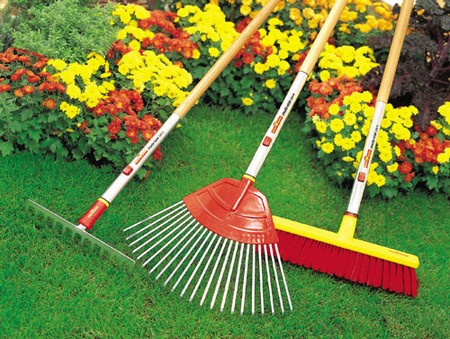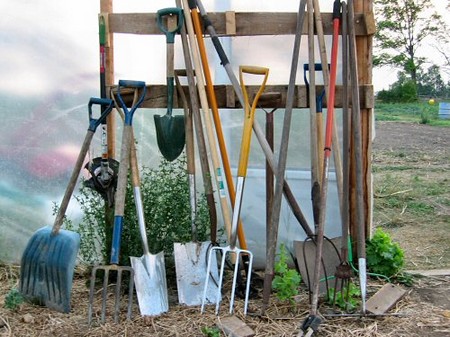Best Way to Choose the Right Tools for Gardening
The choice of tools is a highly personal one, and in the end whatever you find easiest to work with will probably be the best tool for the job. Nevertheless I’m going to give you a list of fifteen tools that I use regularly in my own garden because they work well and add pleasure to the job, and I would like you to have the same pleasure.
This doesn’t mean you have to rush out and buy all of them immediately. There are some you won’t need for a season or two and some that will double for others. A few of them may not be for you at all. Cut-and-hold flower scissors, for instance, that need one outstretched hand only, enable me to cut and deadhead flowers without falling into the border. You may get more fun than I do out of crawling under shrubs to get out dead leaves, in which case you won’t need the claw cultivator. I use a pitchfork to lift big piles of compost, but you may do as I did for years and use your regular garden fork.
Unfortunately, the most essential tools, like the spade and border fork, are the ones that are going to cost the most, and in my opinion you cannot economize on either. I went through any number of inexpensive ones in short order before I found the ones that I have been working with now for over ten years (and expect to use for another ten). Most of the tools on the list are standard and available anywhere, but two of them are not. I’m suggesting them to you here because, in my garden, helpers and students alike have been so taken with them that they have bought their own and abandoned their old ones.
One of the special tools is the Dutch hoe. Some years ago, when I couldn’t find one in this country, I had to bring one from England. I’m glad to see now that it is listed in several catalogs, sometimes as “Dutch scuffle hoe.”
I don’t get along well with hoes in general, but this one is a real pleasure to use. To begin with, you don’t have to keep lifting it up, hacking and chopping down (impossible in a flower border, anyway) and filling your boots with earth. It’s a push hoe, and you “scuffle,” with the blade no more than an inch or two below the soil’s surface and parallel to it. There’s less wear and tear on both the gardener and the plants.
The second special tool is the border fork, more often called a spading fork in this country. But, being designed for use in close flower plantings, it is smaller and narrower, and I have yet to see it in stores. The stainless-steel head with four tines, and the plastic-coated D-grip handle make it an unbeatable tool. So far, the only forks constructed like this that are available here are British-made (no chauvinism, I assure you). This tool, with others of similar quality (including stainless-steel hand tools and a stainless-steel Dutch hoe), appears in many catalogs. The tools are expensive so it pays to do some comparison shopping among the catalogs.
When you look at the first two tools on the list, you’ll see that I make a distinction between spade and shovel and their respective functions. Digging, which involves cutting down into the soil, often through turf, is most efficiently done with a spade, which has a straight and sharp cutting edge. The shovel is best used for scooping up and carrying soil, manure, and gravel, for example. It makes an inefficient digging tool. Calling each by its right name might begin to put things straight.
I don’t offer detailed advice on such items as wheelbarrows or garden carts—I know you won’t be gardening very long before you realize you’re spending a lot of time and muscle just getting things from here to there, and you won’t do without them. What I will tell you is that the most pricey are not necessarily the best.
Don’t buy a wheelbarrow unless its balance (and yours) is excellent, and don’t buy the biggest garden cart in the store or catalog unless it comes with the pony or donkey required to pull it when loaded. Several lightweight, less expensive and probably short-lived carts (though I have a veteran that’s twenty years old and still sturdy), will be more useful. It’s funny how you always need one more wheelbarrow, cart, or whatever it is, so do yourself a favor and get it.
Neither am I about to go into the myriad accessories in stores and catalogs, some useful, some less useful: a tarpaulin, for sliding heavy plants from one place to another; hoses, buckets, and watering cans; compost thermometers, rain gauges, plant supports and twine; plant labels, hanging baskets, fertilizers, boots and boot scrapers; gardeners’ gloves, knee pads and kneeling mats; Sussex trugs; trellises, bowers, pillars, gazebos, and the odd Greek temple.
I am reminded of a modest little establishment in England many years ago, where my father bought his seeds, chicken grain, and, once a year, live chicks. I remember the gloomy interior, its musty smell, and the chaff that made me sneeze. Over the door, in fancy letters, was a sign: “Corn Chandler, Seedsman, Purveyor of Sundries.” What couldn’t that proprietor have done with all these sundries!
Recommended Tools:
- Spade, sharp-edged, for digging;
- Shovel, for picking up and carrying soil, manure, etc.;
- Border fork (spading fork), for lighter digging and border work;
- Pitchfork (compost fork);
- Two rakes, steel-toothed, for soil; wire-toothed, for grass and leaves;
- Dutch hoe for weeding and aerating in the borders;
- Two or three hand trowels, different sizes and shapes, for planting and weeding;
- Hand fork, for small weeds;
- Forked deep weeder, for tap-rooted weeds like dandelions, etc.;
- Claw cultivator, for cleaning up under shrubs;
- Grass shears;
- Heavy shears, for clipping and pruning;
- Long-handled lopping shears, for tougher pruning jobs;
- Hand pruner (clipper);
- Flower cutters, cut-and-hold type.
Categories
Advertisements
Recent Articles
 How to Understand Bed Sizes – A Small Guide
How to Understand Bed Sizes – A Small Guide How to Select Some Must Have Kitchen Accessories
How to Select Some Must Have Kitchen Accessories Best Way to Change a Car Tire
Best Way to Change a Car Tire Best Way to Write an Affirmation
Best Way to Write an Affirmation Best Way to Take Charge of Your Financial Life
Best Way to Take Charge of Your Financial Life Best Way to Survive a Party When You Don’t Know Anyone
Best Way to Survive a Party When You Don’t Know Anyone Best Way to Stop Self Sabotaging Yourself
Best Way to Stop Self Sabotaging Yourself Best Way to Start Journal Writing
Best Way to Start Journal Writing Best Way to Speak with a Powerful Voice
Best Way to Speak with a Powerful Voice Best Way to Simplify Your Life
Best Way to Simplify Your Life Best Way to Respond to a Put-Down
Best Way to Respond to a Put-Down Best Way to Reduce Acne Breakouts
Best Way to Reduce Acne Breakouts Best Way to Recover from Dining Disasters
Best Way to Recover from Dining Disasters Best Way to Quit Your Job Gracefully
Best Way to Quit Your Job Gracefully Best Way to Make Your Own Website
Best Way to Make Your Own Website



Leave a Reply